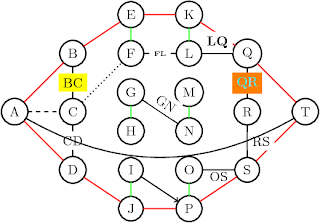
... after the example in the tikz gallery.
\usetikzlibrary{calc,3d}
\newcommand{\setxyz}[1]{%
\pgfmathsetmacro{\xone}{cos(180+#1)}%
\pgfmathsetmacro{\yone}{sin(180+#1)}%
\pgfmathsetmacro{\xtwo}{cos(360-#1)}%
\pgfmathsetmacro{\ytwo}{sin(360-#1)}%
}
\setxyz{17}
\begin{tikzpicture}%
[x = {(\xone cm,\yone cm)},
y = {(\xtwo cm,\ytwo cm)},
z = {(0cm,1cm)}]
\GraphInit[vstyle=Shade]
\SetVertexNoLabel
\begin{scope}[canvas is xy plane at z=-5]
\Vertex{x}
\end{scope}
\begin{scope}[canvas is xy plane at z=0]
\grEmptyCycle[prefix=a]{5}
\end{scope}
\EdgeFromOneToAll{x}{a}{}{5}
\Edges(a0,a1,a2,a3,a4,a0)
\begin{scope}[canvas is xy plane at z=5]
\Vertex{y}
\end{scope}
\EdgeFromOneToAll{y}{a}{}{5}
\end{tikzpicture}







